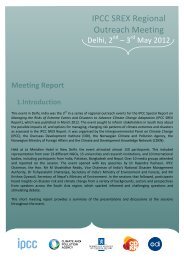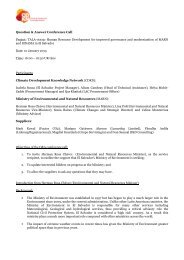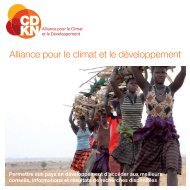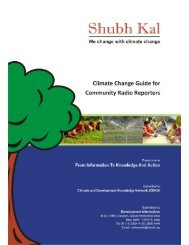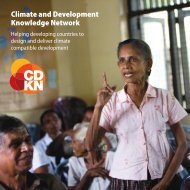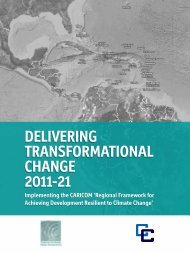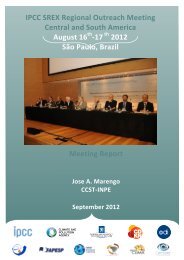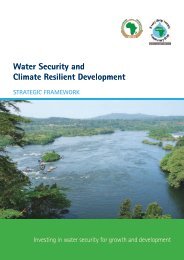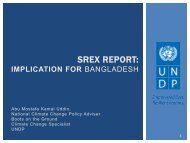species, communities and ecological processes that are a key element to the conservation ofbiodiversity, especially in areas where human activities have changed ecosystems.Biodiversity and Adaptation to Climate Change based on ecosystemsLinking climate change and biological diversity is a topic of great importance since they are mutuallyinterrelated. On the one hand it is important to consider the influence of climate change on biodiversityand how biodiversity changes affect climate change. Reducing the impacts of climate change onbiodiversity is a key factor. The resilience of biodiversity to climate change can be improved by workingto decrease the climatic stresses (pollution, loss and fragmentation of habitats, etc.) combined withconservation strategies, restoration and sustainable management.Currently, it has been proposed the ecosystem-based adaptation as a strategy to climate change thatcan be accomplished, among other ways, through conservation and ecosystem management, using the"multiple" services and functions that are offered to humans.The Ecosystem-based Adaptation (EbA) is the use of biodiversity and ecosystem services, as part of anoverall adaptation strategy to help people adapt to the adverse impacts of climate change 76 .Equally important is to consider the adverse impact of climate change on marine and coastal biologicaldiversity, for example, rising sea levels, oceans acidification and coral bleaching 77 . This makes us reflectthat biodiversity both terrestrial and marine are an important tool for adapting to climate change andespecially Central America that is located between the Atlantic and Pacific oceans. In this regard, itbecomes urgent use protected areas as a conservation strategy and strengthen them under themodalities of conservation indicated above.In order to achieve this great challenge as Central American region to promote the highest level decisionto incorporate in the political agenda with regard to significantly reduce the current rate of biodiversityloss. Also, the region should assess the costs of no-integration to find an overall approach that allows abetter adaptation to Climate Change based on the ecosystems. These agreements must be initiated by:Reducing pollution, controlling the inappropriate use of biological diversity, prevents losses andfragmentation of ecosystems 78 , with particular emphasis on forests 79 .At last, it is important to strengthen the systems and subsystems of protected areas and promote itsconnectivity 80 ,this can be through ecological or biological corridors or landscape linkages, greenbeltsand other forms of connectivity elements, restoration of degraded habitats and landscapes and toconsider between marine and terrestrial landscapes and of course social participation 81 .76 UICN, 2009.77 The Conference of the Parties to the CBD adopted the Programme of Work on Protected Areas in order to establish andmaintain in 2010for land areas, and in 2012, for the sea, "complete national and regional systems, effectively managed andecologically representative protected areas "that collectively, inter alia, contribute to achieving the objectives of the Conventionand the 2010 target to significantly reduce the current rate of biodiversity loss.78 Ecosystems provide a wide range of provisioning services (food, medicine, and fiber, adjustment to climate change and flooding,soil formation, providing human welfare, including health, livelihood and others.79 Forest fragmentation is one of the biggest problems facing the forests. (INAB/MARN). Identification and prioritization of forestcorridors in Guatemala. 2005. P. 92.80 Landscape patterns that promote connectivity for species, biological communities and ecological processes are a key element inthe conservation of nature in environments that have been modified due to human impacts. (Bennett, A. 2004).81 CDB/Biodiversity and Climate Change. 2009) / Secretariat of the Convention on Biological Diversity. (2009 / Bennett, A. (2004).20
General thematic introduction on Climate Change Adaptation"An agreement on climate in Copenhagen this year is an unequivocal requirement toprevent climate change to be left uncontrolled." - Yvo de Boer, Executive Secretary of the UnitedNations Framework Convention on Climate Change, August 2009During 2009, the issue of climate change has grown in interest, as the date approached for the COP15 82 , COP is now approaching 16 in Cancun, Mexico - many analysts, politicians, international experts,media , international leaders, groups and social movements express their expectations and viewson what should be expected of these conferences and meetings 83 . In Denmark it was developed themost important conference for the future of Mother Earth- Pacha Mama for Central American andCaribbean peoples-where you will find large populations of people and livelihoods that are highlyvulnerable to climate change 84 . There were great expectations about the results of theconference 85 . U.S. president, Barack Obama made his presentation, demonstrating the government'sinterest and concern on the issue. The countries of the European Union also presented their lettersand also China - major agreements: the United States will reduce its emissions by 7% 86 , the EuropeanUnion committed to a 20-20-20 87 and China with a commitment to a 40% emissions reduction that willbe achieved due to better energy efficiency 88 . For all these efforts to have a positive impact on futureclimate concentration it should not raise over the 350 ppm 89 established level and should maintain thecommitment not to reach a temperature higher than 1.5 C°.In this XV United Nations Conference on Climate Change, it is expected to conclude an agreement totake effect when the first phase of the Kyoto Protocol in 2012 finished. The meeting would be theculmination of a process that began in 2007 when the governments meeting at the United Nationsconference on climate change held in Bali (Indonesia), launched the Bali Roadmap, a twoyearnegotiation process to prepare an ambitious and efficient international instrument on climatechange that would give continuity to the first stage of the Kyoto Protocol. This process was carried out intwo negotiation directions to establish the post-2012 90 commitments:1) negotiations on the Framework Convention of the United Nations on Climate Change (UNFCCC) onthe basis of the Bali Action Plan, and2), negotiations under the Kyoto Protocol, in which the United States, has not participated, the largestemitter of greenhouse gases, due to the fact that it has not ratified the Protocol. The countriesagreed that negotiations would conclude in the United Nations Conference on Climate Change to beheld in Copenhagen.The conclusions of scientific reports gave great impetus to the deliberations, in particular the FourthAssessment Report of the 2007 of the Intergovernmental Panel on Climate Change (IPCC), which82 United Nations conference call relating to Climate Change Conference of the Parties or its acronym in English COP, the numberindicates how many were made, the year 2010 COP 16 will be held in Cancun, Mexico. Note A. Ponce. Estelí. September 2010.83 Now the hope is COP 16 in Cancun, Mexico. Is the COP 16 more of the same? What role will be that each country must takeespecially those most affected by climate change and the poor? Note Ponce, A. October 2010.84 IPCC reports, IAACC, UNDP Human Development Report. 2008, Ehrhart et. to 2009, Angie Daze, CVCA Manual et.al 2010.85 Now hopes for a path towards a climate neutral and a joint vision for the future to address the issue of climate change areset on Cancun, Mexico. Only one irresponsible, and will have climate change anywhere in the World President of Guatemala-Álvaro Colom-reading lesson on Maya worldview and climate change at the United Nations University of Japan. October 2010.86 According to analysts at COP this corresponds to a 4% reduction is taken into account the parameters of the Kyoto Protocol.87 20% reduction of GHG emissions from energy efficiency, 20% compliance with emissions reduction and 20% through projectfinancing climate change mitigation. Source: Agreements COP 15.Copenhagen, Denmark. December 2009.88 Commitments by the U.S., Europe and China at COP 15, the intricacy of this commitment to China analysts say the COP is theverification of compliance. Copenhagen, Denmark. December 2009.89 Position of the Countries of Central American Integration System. November 2009. Central America on Climate Change.Presentation by Javier Perez. June 26, 2010.90 This is expected to remain active and enthusiastically set at COP 16 in Cancun Mexico now. This document is "live" and builds onthe progress of a subject equal to or more dynamic than the same human actions that deserves the same brisk pace as climatechange, many issues have yet to be clarified will be reflected in this document, but will be an entry point for raising awareness onthe effects of climate change, measures to cope and the effects on indigenous peoples. Note A. Ponce. Estelí, November 2010.21
- Page 3 and 4: Executive SummaryCentral America is
- Page 5 and 6: Central is located in the "Ring of
- Page 7 and 8: Study ContentAs an innovative theme
- Page 9 and 10: that coexist in the universe. This
- Page 11 and 12: Central America level, is the only
- Page 13 and 14: of Mesoamerica has been explained a
- Page 15 and 16: possesses effective cultural commun
- Page 17 and 18: Additionally, to succeed and achiev
- Page 19: eforestation, hydrological planning
- Page 23 and 24: Central American Governments should
- Page 25 and 26: projected 109 conditions, changes o
- Page 27 and 28: General introduction on the themati
- Page 29 and 30: participatory manner, to address di
- Page 31 and 32: Causes and complementary consequenc
- Page 33 and 34: Organizational and legal contextWhi
- Page 35 and 36: The three bodies within the SICA ar
- Page 37 and 38: Based on research of available info
- Page 39 and 40: SE-CONREDCivilProtectionSNETCCNISCO
- Page 41 and 42: Synergy model that displays the add
- Page 43 and 44: Added value of indigenous and local
- Page 45 and 46: They do not work in a separate mann
- Page 47 and 48: demand for agricultural raw materia
- Page 49 and 50: Amazon DIPECHO Project “Strengthe
- Page 51 and 52: Indigenous Knowledge on DisasterMit
- Page 53 and 54: The combination of indigenous andsc
- Page 55 and 56: Indigenous Skills and the mysticism
- Page 57 and 58: Weather forecast through indigenous
- Page 59 and 60: In various international convention
- Page 61 and 62: Recommended ReadingBennett, A., 200
- Page 63 and 64: ILO, 1993, Convenio sobre pueblos i
- Page 65 and 66: Local knowledgeIncludes people and
- Page 67 and 68: which are threatswith a certainprob
- Page 69 and 70: Appreciates and respects their orga
- Page 71 and 72:
framework, without taking into acco
- Page 73 and 74:
Currently Cacaopera ethnicity, alth
- Page 75 and 76:
IDH 228 For 2007 is of 0.6999Politi
- Page 77 and 78:
The Mayangnas are people who are de
- Page 79 and 80:
Rights of detainees to receive info
- Page 81 and 82:
Heritage Protection Article 128The
- Page 83 and 84:
19/09/1996 Law no. 230 Amendments a
- Page 85 and 86:
Indigenous Population:IDH 241 In 20
- Page 87 and 88:
Honduras, each has a different orig
- Page 89 and 90:
MISQUITOS 248 :In 1996 there were 3
- Page 91:
Internationalconventions signed wit



